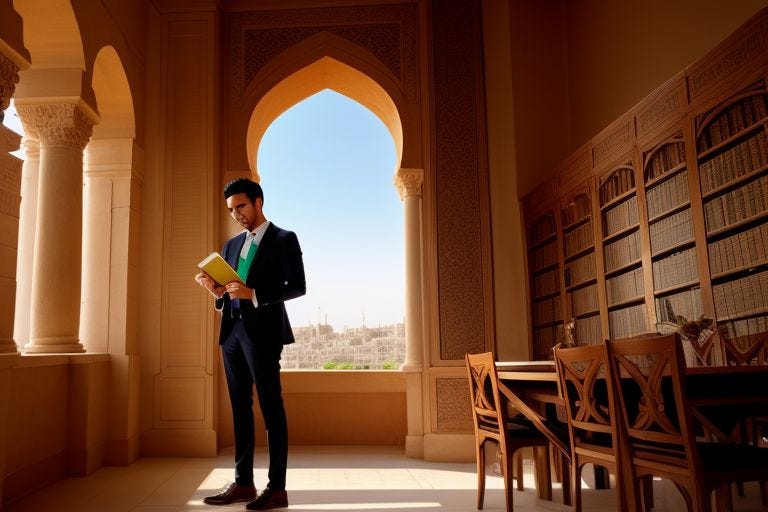Ronit Ricci in her research published in the Journal of World Literature 1 (1), 68-80, 2016 writes that “Interlinear translations from Arabic into Malay and Javanese have been produced in Southeast Asia since at least the sixteenth century.”
Ronit Rocci then gives a brief explanation of how these texts were constructed. She writes, “Such translations included an Arabic original with its lines spaced out on the page and a word for word translation appearing between the lines, attempting to replicate the Arabic down to the smallest detail.”
This is the traditional interlinear glossed format that was a standard tool for practical language study from the medieval.petiod and onwards, with the emphasis on the practical.
This method of learning is most emphatically not ‘academic’, and after the rise of the common universities in the 1800’s with their new technical and oh so perfectly grammatically pure language departments, this ‘unscientific’ and ‘ungrammatical’ methodology that had been used for centuries , the interlinear text gloss, was rejected. Glossed texts became a specialised linguistic tool only found in the new linguistic anthropology departments, where they were used as technical tools for recording tribal languages.
The entry of the university into modern language study is a recent development, for example Oxford University only started offering a couple of modern languages in 1847. This ‘academisation’ of language instruction is only part of the story of why interlinear methods died out in the Western education system, after being used successfully for well over a thousand years.
Hamilton was developing and fine tuning his interlinear system just at the time the professionalisation of Modern language instruction was taking place. The focus was on grammar, and interlinear texts, necessarily, are ungrammatical, and do much violence to the organic syntax of both languages. The academics found them wholly objectionable on these grounds. It did not matter that they were useful.
Outside the universities, interlinears persisted for a while, and in some countries they never quite fell out of use as educational tools.
These type of texts were still used in Sumatra until the early twentieth century. Aglaia Iankovskaia, in her paper ‘Reading Arabic in Sumatra: Interlinear translation in didactic contexts’, published in Indonesia and the Malay World 52 (153), 221-242, 2024, writes at length about interlinear texts.
She observes that glossed interlinear texts have been traditionally used for teaching in Indonesia’s Islamic schools. Written in classical Arabic, the resources are provided with translations to Malay or some other languages translated and annotated between the lines.
Aglaia Iankovskaia notes two types of interlinear translation from Arabic to Malay. One is phrase-by-phrase and the other, word-by-word. Both types combine literality with interpretation, a feature of the Hamiltonian method I have written about elsewhere.
These interlinear translations served a dual.purpose, firstly as a tool for teaching the Arabic language and secondly, to impart the basics of Islamic doctrine.
This method was not only used for Islamic texts in Arabic. The Medici Oriental Press, The Typographia Medicea, operating in Rome between 1584-1614 also produced Arabic interlinears. Robert Jones writes about these texts in his article ‘The'Arabick'Interest of the Natural Philosophers in Seventeenth-Century England, 88-108, 1994.
The Typographia Medicea under the direction of Giovan Βattista Raimondi. In the year 1590/1 published The Gospels in an unidentified Arabic version, with the wood-cut illustrations of the life of Christ designed by the Florentine painter Antonio Ternpesta. This was published in two different editions, the first in Arabic alone, and the second with an interlinear Latin version made by a team of translators working for the press. This was a costly undertaking.
These were not the only interlinear Arabic texts published at this time. Many compilations in Arabic with a Latin gloss were produced by various publishing houses in Renaissance Europe, for both Christian and Islamic texts.
The method of teaching in an Arabic or Persian linguistic environment using interlinear texts still persists in much of the Arabic and Persian speaking world, with modern textbooks and workbooks still being produced in Saudi Arabia, North Africa, Iran and Iraq. Some useful research papers on the methodology in these contexts has been published, demonstrating the utility of interlinear glossed texts for foreign language study.
Learning Arabic using interlinear texts outside the university context has a long history. The Latinum Institute with its Arabic English interlinear glossed lessons series is simply continuing the story.


